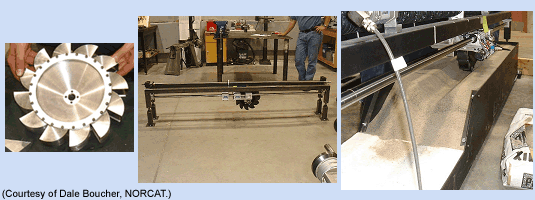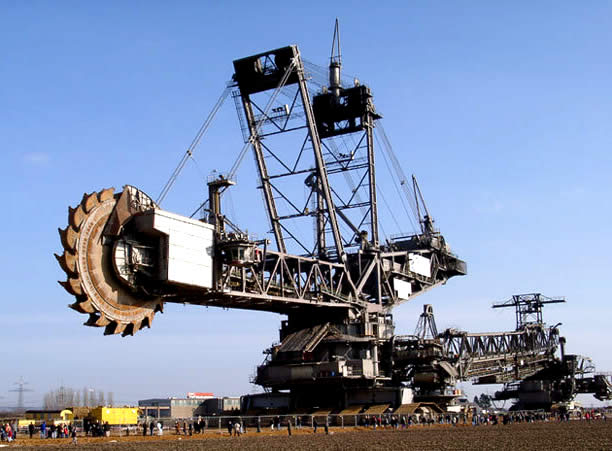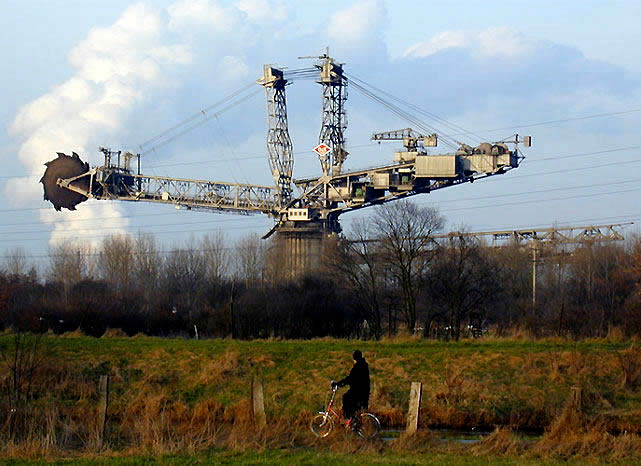|
Lunar Mining Possibilities |
||||
|
BUCKET WHEEL EXCAVATOR Dale S. Boucher1, Jim Richard2 1Northern Centre for Advanced Technology Inc. 1400 Barrydowne Road, Sudbury, Ontario, Canada, P3A 3V8 2Electric Vehicle Controllers Ltd, 2200 Valleyview Road, Val Caron, Ontario, Canada, P3N 1L1 Phone: (705) 521-8324 x202, email: dboucher@norcat.org The Northern Centre for Advanced Technologies Inc. (NORCAT), in partnership with Electric Vehicle Controllers Ltd. (EVC), is presently engaged in the development and adaptation of existing mining technologies and methodologies for use extra-terrestrially as precursor and enabling technologies for ISRU and for use as ISSE in support of longer term missions. More specifically, NORCAT, in collaboration with Colorado School of Mines, has developed, constructed, and tested a bucket wheel excavator. The unit is based upon the design developed by CSMs Mike Duke and Tim Muff. The design of the test unit was developed with the CSM design as a guide. Considerations were exercised to facilitate construction and testing of key operational parameters. This yielded some changes in design and operating concepts, which were incorporated where appropriate. In addition, some bottle necks and weak points were identified in the original design. NORCAT engaged Natural Resources Canada (NRCan) to fabricate a lunar regolith simulant from mine tailings that would exhibit some significant similarities to the reported mechanical properties of lunar regolith. The Bucket wheel unit was tested in this simulant in October 2004. This presentation will report some key results of the Bucket wheel re-design. Meeting Abstract: Space Resources Roundtable VI (2004) 6004.pdf |
||||
| Posted by johnlear, on November 24, 2006 at 16:30
GMT
http://www.abovetopsecret.com/forum/single/2639774.html Originally posted by ignorant_ape ZORGON : No offence , but you are in grave danger of contradicting yourself and other " moon mine proponents " It might seem so but actually he's not. As a matter of fact that is why we are calling many of these companies. We are trying to find out why all of this preparation is being made and why they are considering using rocket propulsion when we are obviously already there, and obviously, if rocket propulsion is being used, it being very well hidden. On my first call to the Canadian company, the gentlemen started asking ME a bunch of questions. I said allow me to cut to the chase. We are looking at pictures taken in 1966 by Lunar Orbiter which shows a large mining operation in the Crater Copernicus with buildings, excavators, ramps, arches along with smoke, vapor and dust. Since you are building and testing a bucket wheel excavator for extraterretrial use we were wondering if you knew about this moon operation. His answer was 'yes'. I then asked then why were they building and testing a bucket wheel excavator if one was already on the moon. He answered that they had a number of government contracts for all kinds of things. The bucket wheel excavator was just a small contract and that they were no longer working on it. I asked how big the excavator was. He answered "14 inches high". Go figure. An insider I talked to in 1990 told me that he worked on a piece of mining equipment for the moon that was 30 stories tall. He told me that toward the end of the contract he rented an airplane and flew around it just to get an idea of its enormous size. So by accident Zorgon stumbled onto all of this mining information and it appears that a massive, well organized effort is under way to prepare to mine on the moon and mars. We are considering that the possibility exists that they have decided to make the operation public. And rather than just say "We lied and Mercury, Gemini and Apollo were just window dressing", they are ramping up for public disclosure that will dovetail into whats already there in such a why that nobody will suspect we have been there for 45 years. NOTE: When John called the gentleman, he got an answering machine and left a simple message... we would like to get some information on bucket wheel excavators... nothing more... nothing about the moon etc... When Dale returned the call his first question was "What's your clearance level?". Since Norcat is a government contractor I would imagine their caller ID is more than just a name and number. But in the conversation Dale did volunteer that Tim Muff is no longer with them and is now working at Lockheed Skunkworks... There was no real reason to tell us this, we never asked... It is bits and clues like this that tell us they are leaving us bread crumbs to follow... |
||||
|
||||
| Norcat: Northern Centre for Advanced Technology Inc.
Sudbury Ontario Canada is one of the richest mining areas in Canada, with an abundance of Nickle and Cobalt. Sudbury is also a Meteorite Impact Crater. Norcat runs Lunar and Mars mining methods and equipment demos at an Annual Symposium... Excerpt... Sudbury To Host Planetary And
Terrestrial Mining Sciences Symposium
For manned missions to Mars and other distant planetary bodies it becomes essential to develop ways to produce fuel for rovers and return crew exploration vehicles during the mission. Sudbury is home to the world's largest concentration of mining technology expertise and area companies have been mining the 1.87-billion-year-old impact crater for more than 100 years. At first glance it may be difficult to see what connection that has to the space industry, and why we should care; a closer look reveals not only a strong link, but a compelling economic reason. Mining technology developed for use here on earth has already been used as the basis for developing the technology required to mine the moon and Mars. Dale Boucher, Director of Research and Development at the Northern Centre for Advanced Technology Inc. (NORCAT), indicates NASA and the CSA approached NORCAT several years ago to leverage Northern Ontario's drilling expertise derived through the mining industry. That initial meeting in 2000 developed into a collaboration that continues to date. |
||||
| Not Your Daddy's Mining Gear
Excerpt Dale Boucher and Jim Richard (Northern Centre for Advanced Technology, Inc., NORCAT, located in Sudbury, Ontario, Canada) shared their expertise in mining. It begins with searching for a potential resource (prospecting), which we have already started to do for the Moon and Mars through human (to the Moon) and robotic (to both) missions. Once identified you explore the prospect in detail (implying spacecraft that land on the surface), then mine it. The mined materials are usually beneficiated (minerals separated and concentrated), though this might not be necessary at first on the Moon. We then process the mined materials to make products (e.g., metallic iron, oxygen, water). This step produces some waste, that must be managed, and useful products. This is, among other things, applied cosmochemistry at its most artful. The trick, Dale Boucher told Roundtable participants, is to transform
traditional Earth-based mining equipment into efficient and light-weight
gear to use on other planets. He calls it the VAMPS process: Eliminate
Volatiles (we can't use drilling fluids, for example), Automate (make extensive
use of robotics), Miniaturize (lower the size and mass), redefine the Paradigm
(do things completely differently if need be), and Stabilize. The result
is new mining equipment and approaches. An interesting example is the NORCAT
design of a bucket wheel for excavating the lunar regolith. It is small,
takes little power, but can excavate efficiently. Boucher and his team
plan more tests with simulate regolith.
Cosmochemistry
and Human Exploration
|
||||
|
Planetary and Terrestrial Mining
Sciences Symposium
The purpose for this conference is to promote a closer relationship between the space and mining sectors. The intent is to allow mining experts to network with space scientists and engineers, to share knowledge, and to foster collaboration. The focus of the conference will be solid planet sciences. Topics will be limited to the science and technology of exploring and exploiting resources on Earth as well as on other planetary bodies, such as the moon, Mars, asteroids, comets, etc. Resource Extraction & Utilization: Rovers and rover payloads
|
||||
|
Concept Lunar Bucket Wheel Excavator
and Lunar Outpost
NASAs return to the Moon by 2020 calls for sustainable human presence, suggesting that crew will make use of local resources for mission consumables. Generally referred to as In Situ Resource Utilization (ISRU), lunar regolith may be mined for small scale production of hydrogen, oxygen, water and volatiles. The Colorado School of Mines constructed and tested a prototype Bucket Wheel Excavator (BWE) in 2003. This vehicle is an early prototype of a common mining vehicle adapted for lunar size and power. We created a virtual model of this vehicle, placing it in a simplified simulated regolith environment to prove that a physics-based, force feedback joystick driven virtual vehicle simulation could be delivered to consumer personal computers via the internet. |
||||
|
||||
| Excavation System Comparison:
Bucket Wheel vs. Bucket Ladder
Bucket Wheel System Description: On Earth large scale mining systems often use bucket wheel excavators in combination with a transportation mechanism (e.g. conveyor belts). On the Moon the bucket wheel is beneficial because the digging forces pull the excavator down and allow for a lighter design of the mobility platform. A disadvantage of the bucket wheel system is that the wheel only digs, another system is required for transportation of the dug up material to the processing location. Because the scaling of large terrestrial systems to small scale planetary rover type systems is very difficult a prototype was built at CSM to test the small scale excavator system. The bucketwheel was designed to dig up 50 kg/hr and has 5 cm wide buckets that are mounted on a wheel of 20 cm diameter. The wheel is mounted on the end of a swinging boom that allows for vertical as wel as lateral translations of the bucket wheel boom. [3,4] Bucket Ladder System Description: the bucket ladder is also based on a large scale terrestrial mining system that usually involves many cables. The lunar adaptation of this system consists of a rigid frame around which the chains circulate which eliminates the need for the use of cables but limits the length of the ladder. The buckets are directly mounted on the chains. The force directions for the digging part are very similar to the bucket wheel but the bucket ladder has the advantage that it also transports the excavated soil to another system (e.g. a dump reservoir or a hopper or even directly into the processing unit). The rigid frame is connected to an arm that connects the ladder to the mobility platform and allows the bucket ladder to be placed in various positions. |
||||
|
||||
| FAIR USE NOTICE: This page contains copyrighted material the use of which has not been specifically authorized by the copyright owner. Pegasus Research Consortium distributes this material without profit to those who have expressed a prior interest in receiving the included information for research and educational purposes. We believe this constitutes a fair use of any such copyrighted material as provided for in 17 U.S.C § 107. If you wish to use copyrighted material from this site for purposes of your own that go beyond fair use, you must obtain permission from the copyright owner. | ||||
|
|






